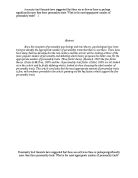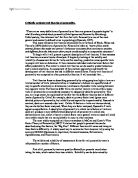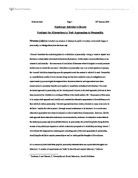The best way to figure out the ideal number of personality traits is to look at temperaments; temperaments are the characteristics of an individual’s emotional behaviour, including their susceptibility to emotional stimuli, quality of prevailing mood, the strength and speed of response and intensity of mood (Allport, 1937, as cited by Piekkola, 2011) due to this being hereditary established habitual patterns can be defined and categorized as personality traits giving a basis on what the most appropriate number of personality traits could be. Eysenck’s three factor model of personality uses a hierarchical system looking at the three main traits Psychoticism, Extraversion/Introversion and Neuroticism and then additional traits are listed underneath these main sections, this categorization was prompted by Goldburg and Rosolack (1994) when they challenged Eysenck to assign a list of trait adjectives to his three factor model primary sections of which the sub sections derive from. The three trait theory falls under this category in which its characteristics are temperaments and derived through biological conditioning, this had been the leading model of personality up until the five factor model, which is explained further down, but this idea and concept of categorizing personality through identifying the biological factors of personality revolutionized the approach taken to identifying key traits and went on to support the work of the Five Factor Model (Costa & McCrae, 1992).
Cattel (1965) did research on trait theory, looking into research by Allport (1936) who had looked at human personality and attempted to describe every single trait, identifying around 4,500 words in the English language that could be used to describe personality traits. Cattel (1965) analyzed this list and deciphered 171 characteristics from the list that were appropriate from the 4,500 proposed by Allport (1936) and using factor analysis identified traits with relations to other traits and reduced the list to 16 personality trait factors; these factors had opposite extremes, abstractedness is the range of imagination a person has to their groundedness, apprehension is range of guilt being felt to the freeness of guilt, dominance is the range of submissiveness and dominance, emotional stability refers to neuroticism and an individual’s tendency to become upset or emotional, liveliness refers to the range of surgency and desurgency, openness to change is the range of conservatism and radicalism, perfectionism is the range of high self-concept control and low integration, privateness shows a willingness to let other people into their live and know what they are doing, reasoning a range of higher a lower scholastic mental capacity, rule consciousness the range of high and low super ego strength, self-reliance is the range between group adherence and self-sufficiency, sensitivity is the difference between being tough and tender minded, social boldness is the difference of being threat sensitive and thick skinned , tension is the range of high to low ergic tension, vigilance is the range of trust and mistrust they have and warmth is the difference of being reserved and distant and being outgoing and easy going. Cattel (1956) self-proclaimed these 16 traits to be the source of all personality and developed the Sixteen Personality Factor Questionnaire (16PF) as a way of measuring these traits. Although all these traits are factors of personality, Cattel (1956) did not look at the temperamental side of personality trait theory and the innate personality traits developed through the passing down of genes through a generation. This can be seen in several of the traits developed by Cattel (1956), self-reliance and tension being two that would seemingly be greatly affected predominantly by the environment over having the built in personality through genes being passed down from parents. Although Cattel (1956) provides valid research into personality traits there are several points that make it stand away from its opposing theories making it’s ideality less appealing; the problem with the 16 personality factor is that many of the traits within the model are just terms that reflect then influence of social pressure and culture (Piekkola, 2011). The 16 personality trait factors also has links to the Five Factor Model, the 16 personality trait factors took around a decade to complete due to the extensive amount of research and development put into the theory, and then additionally to prove its validity across cultures. Through development the sixteen factor theory started becoming very close towards the Five Factor Model, Cattel brought in Second Order traits and Global Factors, Global Factors being Extraversion, which contained primary factors such as social boldness, liveliness, openness, putting the 16 primary traits into smaller groups, similarly to the Five Factor Model, in the fifth edition of the 16 personality trait factors five global factors were incorporated into the study, these five factors were Openness and Tough Mindedness (otherwise known as Openness in the Five Factor), Self-Control (otherwise known as Conscientiousness in the Five Factors), Extraversion (also known as Extroversion), Independence and Accommodation (otherwise known as Agreeableness in the Five Factors) and Anxiety (otherwise known as Neuroticism) (Conn & Rieke, 1994)
The Five Factor Model of personality (Costa & McCrae, 1992) came up with the Five Factor Model to further help understand the framework of personality and relationship between personality and behaviour. This theory was also based on temperamental characteristics meaning that all categories under this theory are derived from biological traits that cannot be inherited through exposure to the environment; these five factors are Openness, Conscientiousness, Extraversion, Agreeableness and Neuroticism (OCEAN) Openness is reflected in strong intellectual curiosity, appreciation for art, emotion curiosity and unusual ideas, Consciousness is the tendency to plan actions through rather than act spontaneously, the ability to show discipline in ones actions, Extraversion is the stimulation from the company of other people, Agreeableness is the concept of going with the flow, being cooperative with other people and follow their lead, Neuroticism is the individuals tendency to become upset easily and experience negative emotions quite frequently, each factor also takes into account their polar opposites as well, so someone not high on extroversion for example would be classed as introverted, someone who is not high in openness would be classed as unimaginative and so forth. One of the strong points that supports the Five Factor Model is the theories remarkable sustainability amongst different cultures, leading it to evidently being a universal theory and accurate among more than 50 different cultures and adaptability through diverse languages without the need for extensive adaptation of the theory (McCrae & Roberts, 1997). The Five Factor Model’s personality traits are based on traits that are hereditary, these hereditary traits are a consistent part of a person’s personality and although certain situations may provoke situational variables the best way to select the ideal number of personality traits is to choose traits that, in most cases, are reflected in a person’s responses to stimuli in a specific way that reflects underlying personality traits. The Five Factor model seems to reflect this in its five traits of personality and is widely accepted as the most accurate model of personality to date thus far.
The theories portrayed show three theories that all have a solid standing ground for their research into the appropriate number of personality traits. What we were looking for in the selection of the appropriate number of personality traits was evidence that the personality traits proposed were biological and not environmental, what this means is, for the purpose of categorizing and labeling personality traits, these traits need to be universal, all these traits need to be able to sustain themselves culturally meaning that although it may apply to personality of western people it doesn’t necessarily mean that the model would work anywhere else in the world, and if it cannot stand across cultures then further research needs to be conducted. The three trait model theory (Eysenck, 1967) is a strong theory which certainly helped develop future theories of personality with its movement into temperaments, focusing on more scientific ways to research personality and the look at biological factors within personality. The 16 personality trait factor Cattel (1965) was a more in depth look; this theory looked more into the multiple types of personality but was far too wide spread, with many of the traits overlapping into each other for example social boldness, liveliness, openness all being able to sit comfortably into Extroversion. The further development of the 16 personality trait factor Cattel (1965) brings into account global factors, which are incredibly similar to the Five Factor Model’s (Costa & McCrae, 1992) own five traits as shown in the evidence provided. The Five Factor Model (Costa & McCrae, 1992) is the strongest model to show, categorize and evaluate personality traits; The Five Factor model (Costa & McCrae, 1992), whichever adaptation one decides to use, is biologically based, stable, universal and uninfluenced by culture, these five traits are the ideal number of personality traits to have as they are like a basic structure able to serve as a foundation to build upon.
References
Piekkola, B. (2011). Traits across cultures: A neo-Allportian perspective. Journal Of Theoretical And Philosophical Psychology, 31(1), 2-24. doi:10.1037/a0022478
SAVA, F. A., & POPA, R. I. (2011). PERSONALITY TYPES BASED ON THE BIG FIVE MODEL. A CLUSTER ANALYSIS OVER THE ROMANIAN POPULATION. Cognitie, Creier, Comportament/Cognition, Brain, Behavior, 15(3), 359-384.
Borgatta, E. F. (1959). A Broad Empirical Approach to Personality: Personality and Motivation Structure and Measurement. Sociometry, 22(2), 148-152.
McCrae, R. R., & Costa, P. r. (1997). Personality trait structure as a human universal. American Psychologist, 52(5), 509-516. doi:10.1037/0003-066X.52.5.509
Conn, S.R., & Rieke, M.L. (1994). The 16PF Fifth Edition technical manual. Champaign, IL: Institute for Personality and Ability Testing, Inc.
McCrae, R.R., & Costa, P.T. (1987) Validation of the five-factor model of personality across instruments and observers. Journal of Personality and Social Psychology, 52, 81-90.
McCrae, R. R., Terracciano, A., and Members of the Personality Profiles of Cultures Project. (2005). Universal features of personality traits from the observer's perspective: Data from 50 different cultures. Journal of Personality and Social Psychology, 88, 547-561.
Cattell, R.B. (1965). The scientific analysis of personality. Baltimore: Penguin Books.
McCrae, R.R., & Costa, P.T. (1997) Personality trait structure as a human universal. American Psychologist, 52, 509-516.
Eysenck, H.J. (1992). Four ways five factors are not basic. Personality and Individual Differences, 13, 667-673.
Eysenck, H. J. (1957). The effects of psychotherapy: An evaluation. Journal of Consulting Psychology, 16, 319-324.









